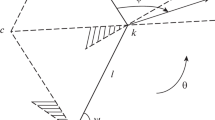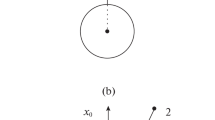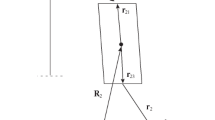Abstract
The method of arranging a tether group of four spacecraft as triangular beam constellation is considered in this paper. The group consists of a central spacecraft, from which the tethers are released, and three small spacecraft (satellites). After arrangement, the group is a triangular beam symmetric constellation of spacecraft stabilized by rotation with a certain specified angular velocity. When arranging the group, it is proposed to use a combined control method, which consists in the joint use of low-thrust engines located on satellites and tether release devices that ensure their smooth braking at the final stage of system arrangement after the engines are turned off. To select the control laws for the arrangement of the system, a mathematical model of the plane motion of the system constructed using the Lagrange equations is developed and used. To check the feasibility of the proposed control laws, a more complete spatial mathematical model of the system motion is used, which takes into account the motion of the spacecraft and satellites relative to their centers of mass, the extensibility and one-sidedness of mechanical links (tethers), disturbances during separation of spacecraft, inaccuracy in knowing the initial angular velocity of rotation of the system before separation, etc.
Similar content being viewed by others
REFERENCES
Beletskii, V.V. and Levin, E.M., Dinamika kosmicheskikh trosovykh sistem (Dynamics of Space Tether Systems), Moscow: Nauka, 1990.
Bainum, P.M., Harkness, R.E., and Stuiver, W., Attitude stability and damping of a tethered orbiting interferometer satellite system, J. Astronaut. Sci., 1972, vol. 19, no. 5, p. 364.
Breakwell, J.V. and Andeen, G.B., Dynamics of a flexible passive space array, J. Spacecr. Rockets, 1977, vol. 14, no. 9, pp. 556–561.
Shi, G., Zhu, Z., and Zhu, Z.H., Dynamics and control of tethered multi-satellites in elliptic orbits, Aerosp. Sci. Technol., 2019, vol. 91, pp. 41–48.
Wang, Ch. and Zabolotnov, Yu.M., Analysis of the dynamics of the formation of a tether group of three nanosatellites taking into account their motion around the centers of mass, Mech. Solids, 2021, vol. 56, no. 7, pp. 1181–1198.
Pizarro-Chong, A. and Misra, A.K., Dynamics of multi-tethered satellite formations containing a parent body, Acta Astronaut., 2008, vol. 63, pp. 1188–1202.
Slane, J.H. and Tragesser, S.G., Stability and control of tethered satellite formations, AIAA/AAS Astrodynamics Specialist Conference, 2012, AIAA 2012-4658, pp. 1–8.
Huang, H., Zhu, Y., Yang, L., et al., Stability and shape analysis of relative equilibrium for three-spacecraft electromagnetic formation, Acta Astronaut., 2014, vol. 94, pp. 116–131.
Cai, Z., Li, X., and Wu, Z., Deployment and retrieval of a rotating triangular tethered satellite formation near libration points, Acta Astronaut., 2014, vol. 98, no. 1, pp. 37–49.
Cai, Z., Zhou, H., and Li, X., Nonlinear dynamics of a rotating triangular tethered satellite formation near libration points, Aerosp. Sci. Technol., 2018, vol. 42, pp. 384–391.
Williams, P., Optimal deployment/retrieval of a tethered formation spinning in the orbital plane, J. Spacecr. Rockets, 2006, vol. 43, no. 3, pp. 638–650.
Huang, J., Li, C., and Ma, G., Nonlinear attitude tracking control of underactuated three-inline tethered satellite, Acta Aeronaut. Astronaut. Sinica, 2015, vol. 36, no. 6, pp. 1995–2004.
Bae, Y.K., A contamination-free ultrahigh precision formation flight method based on intracavity photon thrusters and tethers: photon tether formation flight (PTFF), Final Report. Program 07605-003-041, Washington, DC: NASA, Inst. for Adv. Concepts, 2006, p. 72.
Young, K., A contamination-free ultrahigh precision formation flying method for micro-, nano-, and pico-satellites with nanometer accuracy, Space Technology and Applications International Forum STAIF 2006, American Institute of Physics, 2006, pp. 1213–1223.
Misra, A.K. and Pizzaro-Chong, A., Dynamics of tethered satellites in a hub-spoke, Adv. Astronaut. Sci., 2004, vol. 117, pp. 219–229.
Zhao, J. and Cai, Z., Nonlinear dynamics and simulation of multi-tethered satellite formations in halo orbits, Acta Astronaut., 2008, vol. 63, pp. 673–681.
Avanzini, G. and Fedi, M., Effects of eccentricity of the reference orbit on multi-tethered satellite formations, Acta Astronaut., 2014, vol. 94, pp. 338–350.
Zhai, G., Su, F., Zhang, J., et al., Deployment strategies for planar multi-tethered satellite formation, Aerosp. Sci. Technol., 2017, vol. 71, pp. 475–484.
Su, F., Zhai, G., Zhang, J., et al., Dynamics and control during spinning deployment for hub-and-spoke configured multi-tethered satellite formation, Acta Aeronaut. Astronaut. Sinica, 2016, vol. 37, no. 9, pp. 2809–2819.
Huang, P., Zhao, Y., Zhang, F., et al., Deployment/retraction of the rotating hub-spoke tethered formation system, Aerosp. Sci. Technol., 2017, vol. 69, pp. 495–503.
Alary, D., Andreev, K., Boyko, P., et al., Dynamics of multi-tethered pyramidal satellite formation, Acta Astronaut., 2015, vol. 117, pp. 222–230.
Yarotsky, D., Sidorenko, V., and Pritykin, D., Three-dimensional multi-tethered satellite formation with the elements moving along Lissajous curves, Celestial Mech. Dyn. Astron., 2016, vol. 125, no. 3, pp. 309–322.
Pizzaro-Chong, A. and Misra, A.K., Dynamics of multi-tethered satellite formations containing a parent body, Acta Astronaut., 2008, vol. 63, pp. 1188–1202.
Kruijff, M., Tethers in Space, Leiden, Netherlands: Delta-Utec Space Research, 2011.
Zabolotnov, Yu.M. and Naumov, O.N., Motion of a descent capsule relative to its center of mass when deploying the orbital tether system, Cosmic Res., 2012, vol. 50, no. 2, pp. 177–187.
Dong, Z., Zabolotnov, Yu.M., and Wang, Ch., Motion modeling and deployment control of a long-tethered spacecraft system with an atmospheric sounder, Eng. Lett., 2018, vol. 26, no. 4, pp. 478–488.
Shilov, A.A., Optimal direction cosine matrix correction in rigid body rotation calculations, Uch. Zap. Tsentr. Aerogidrodin. Inst., 1977, vol. 8, no. 3, pp. 137–139.
Funding
This study was financially supported by the Russian Foundation for Basic Research and the National Natural Science Foundation of China within the framework of joint scientific project no. 21-51-53002.
Author information
Authors and Affiliations
Corresponding author
Ethics declarations
The authors declare that they have no conflicts of interest.
Additional information
Translated by N. Topchiev
Rights and permissions
About this article
Cite this article
Zabolotnov, Y.M., Nazarova, A.A., Wang, C. et al. The Dynamics of Arranging a Spacecraft Tether Group as a Triangular Constellation. Cosmic Res 60, 375–386 (2022). https://doi.org/10.1134/S0010952522050070
Received:
Revised:
Accepted:
Published:
Issue Date:
DOI: https://doi.org/10.1134/S0010952522050070




